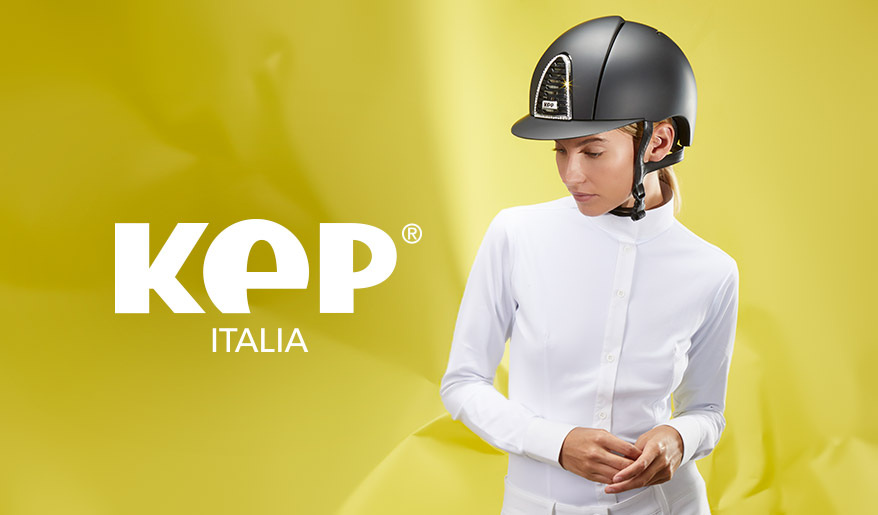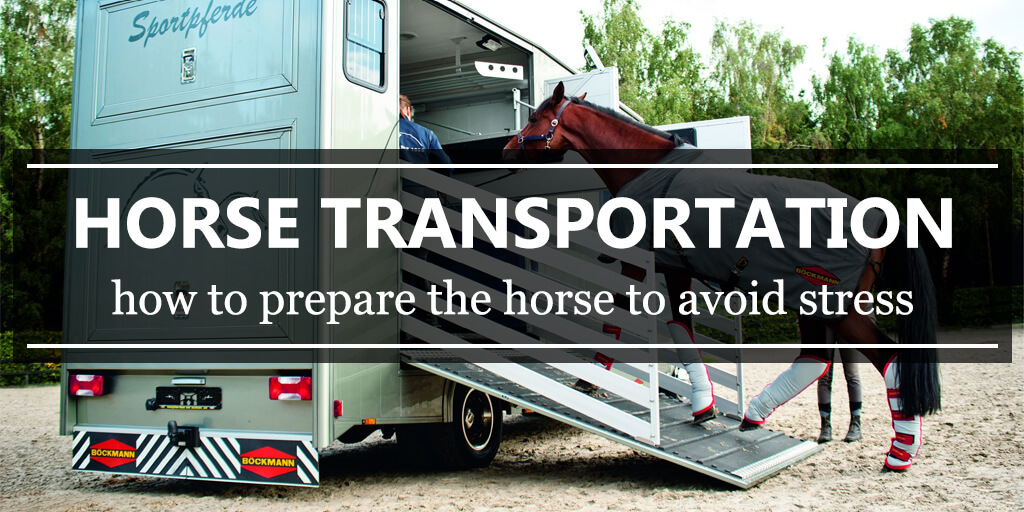
The turn of July and August is the very middle of the riding season. More than one competitions are ahead, which not always are take place at our riding facility grounds or anywhere nearby. Sometimes we have to travel with our horse, at that might be as far as few hundreds of kilometers. Is our charge prepared for that? Or maybe the transport is the least pleasant part of the competition, stressful both for us and our horse?
Let's remember that it is never too late to increase our steed's comfort. Below we present you a few tips how to make the journey more pleasant and make the frustrating situations associated with loading and unloading our favourite fade into oblivion.
Preparing the vehicle to transport
We differentiate two basic means of motor transportation due to which we might carry our horse.
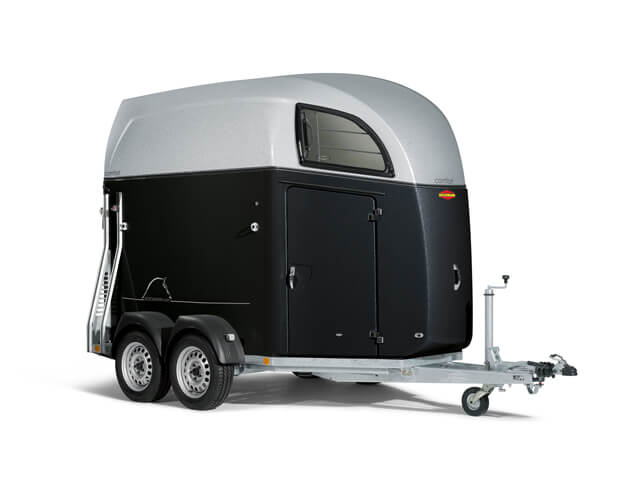
Trailer for two horses.
Trailer - designed for carrying two horses standing collaterally to each other. There is space for a little trunk, which might contain a moderate amount of equestrian equipment, with the saddle hanger. You can enter the trailer from the back or front, so the loading is very easy, also due to the small pitch of the gangplank to the ground.

Horsetruck for 10 horses.
Horsetruck - depending on its size you can carry in it from 2 to 12 horses. We will find here a lot of space for equestrian equipment and other luggage. Those really "fresh" horsetrucks have also lodging places inside, a kitchen and bathroom so that for the competition duration we are self-sufficient and we don't have to spend money on accommodation. An additional plus of the horsetruck is the possibility of loading the horse front. The minus of this transport is a large angle of slope of the ramp in relation to the ground.

Interior of the Oakley Supremacy horsetruck for 6 horses, with lodgings for 6 people.
If this is our own means of transport, it is recommended to check its technical condition after the winter - overrun brake efficiency, condition of the tires, the tires pressure and all kinds of locks, handles, catches, but also lighting. Also, pay attention if any sharp items stick inside (bolts, nails, screws etc.) that might hurt the horse. These king of cuts can not only ruin the opportunity of taking part in the competition, but also contribute to permanent injuries.
The interior of the vehicle should be clad with rubber, and a mattress should be on the height of the horse's log. During driving the horses usually catch the balance by leaning against the walls. Lacking the mentioned before shock absorbers cause painful abrasions, especially in the point of hip area.
The floor and ramp on which the horses enter the horsetruck should also be properly secured. Best, if they are covered with rubber and have lateral rungs which prevent from slipping while entering. Often, in order to provide the closest conditions to those in boxes and to improve the cushioning, horses are transported on litter - straw, sawdust. It is worth to put a thick layer of them so they can urinate without increasing the risk of slipping on wet litter. On the road do not forget that some of the steeds don't feel so comfortable to defecate while riding and during a break, walk the horse and wait until the physiological needs are done.
It is also a good idea to prepare a net with hay for the journey, so our horses will have positive associations with travelling and focus all their attention on cropping the hay - it has calming influence on most horses and helps forget about stress.
Learning of entering the trailer

Many of us forget that teaching the horse to enter the trailer is a long term process which cannot be rushed and be conducted few minutes before departure. Unfortunately, most horses don't go through that training course and the most common sight on the competition is a stressed horse which by means of force and threats (pulling, kicking, whip) is simply pushed into the trailer. It doesn't proclaim good of the rider or the horse's owner and is a really upsetting view.
It's enough to spend a little time so the horse will have only pleasant memories in association with our horsetruck or the trailer. Especially reiteration of loading the horse (without force!) and feeding the horse inside create so strongly positive associations so the horse has no longer problems with entering and travelling.
The first stage of training should be taming the horse to the trailer or the horsetruck view. It is best to leave the closed trailer in a place that is well-known to our horse, for example the pasture, where in the company of other horses, he or she could sniff it and get used to its presence.
The next stage should be opening the trailer and introducing a horse that is already used to it and the operation is not stressful to him. The presence of another horse in the trailer will encourage our steed and reduce his stress in the new situation. Throughout the whole training process, very useful would be rewarding the horse with snacks, carrots, and others that build in the horse's mind positive associations with the vehicle appearance. Of course, the mentioned praise can be obtained by the horse only after the properly performed task, so he or she knows they have to earn it.
Learning how to enter the trailer is a step-by-step process - literally. We reward the horse serially for a front leg put on the gangplank (usually we have to lift and put it), and then for the other front leg etc. It is worth to encourage our horse to take those steps on their own by luring with a carrot before their nose which they cannot reach even when they stretch their neck, but only when they take a step (even a little one, every step should be rewarded).
Do not forget that the horse might give up entering during the process of training. Give him the possibility of leaving the gangplank, even if all four legs were on it. The animal must feel that there is no pressure on them and that it is just fun. If they don't feel like entering again, despite the unfinished attempt - you should let it go and go back to training the next day.
When due to our patience and efforts, the horse will eventually find himself in the trailer, you should richly reward him with hay in net, which ought to become the integral part of the trailer and keep him inside for a while. We can also support him with our presence, voice or stroking. It is worth to try closing the trailer so the horse could get used to this also.
Of course, we are the ones to know our horses best and we see if we should already let go, if the situation hasn't become too stressful for our pet. Remember that we cannot come the acid and it is better to put the next "steps" for another day. One horse will enter after a few minutes, another will need even two weeks to get familiar with it.
We also have to able to foresee that unloading the horse from the trailer might be way more dangerous. It is worth to ask other people for help who will supervise our horse to walk on the ramp. Horse usually doesn't go backwards on the perfect straight line, so by pushing the croup you can control it and prevent the horse from walking on the side verges of the ramp. Such slip of a leg from the ramp might cause a serious injury and ruin the built positive association after the first contact with the trailer.
Company during the journey

source: horse-sport.home.pl
If our horse feels insecure during the journey, it is worth to take another one, because as a social animal, he will be lesser stressed having a companion. The fellow horse must know our steed (the next-box colleague would be perfect!) and of course they have to like each other. That will allow us to avoid the getting-to-know by the horses in our trailer, which is usually accompanied with nervous squeaking, sniffing, kicking (especially when it comes to stallions). This strange horse definitely won't decrease our pet's stress, and can only cause injuries to the horses and devastation of equipment.
Needless to mention that it won't be the best idea to carry a stallion with a mare. Even solidly-looking equipment and partition dividing the horses might be too weak in confrontation with the mass and strength which our four-hoofed have. If we have to carry both a stallion and a mare, they should be separated by geldings or leave free boxes between them, which is possible only in the horsetruck.
Horse during transport
Producers of the equestrian equipment offer wide range of various boots which will provide our horse with protection.
Travelling boots - will be perfect for a journey, protecting the legs from hooves to wrists and hocks. Unfortunately, due to their size, the boots are difficult to launder, as they don't fit into a standard washing machine, and often slide from the nervously mincing horse's legs. For the unfamiliar with them horses they might be an additional difficulty during entering the trailer, because some of the horses don't like to move with them on.

GO HORSE wrappers with backing.
Backing, wrappers, wellies - some owners prefer them instead of the travelling boots. Horses are way more accustomed to them, they don't restrain movements, they're cheaper, and it's easy to launder them. However, they don't protect as well as the travelling boots do and their application (especially the wrappers) requires a knack.
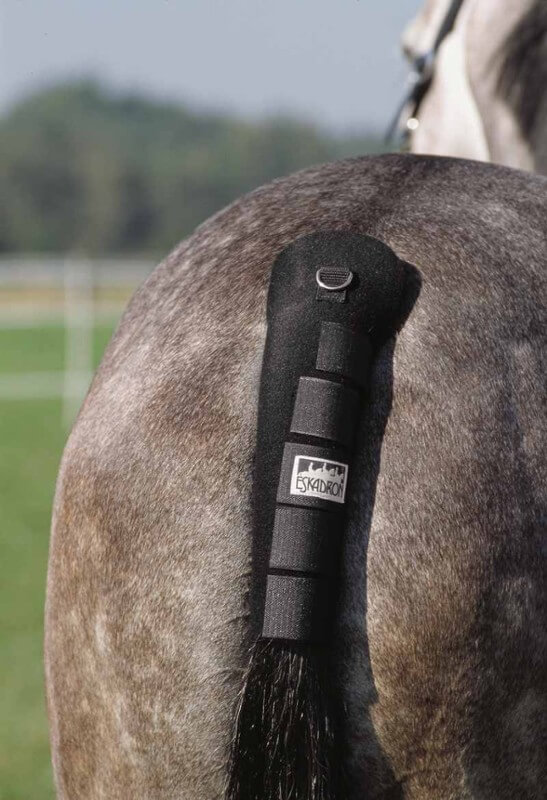
ESKADRON tail protector.
Tail protector - a very clever invention, which prevent the horse from chafing the tail while leaning the croup during transport in order to regain balance. The protector is produced in form of the crupper, attached by special straps that go over the back and are tied on the horse's neck. If we don't have this kind of protector, there is another method, wrapping the upper part of the rail with fleece bandage. It mustn't be wrapped too tightly, as this might lead to hair loss, and in the extreme cases to necrosis of the dock, ending with loss of the tail. It would be easier to put anything on the tail if we brede it in anyway - for example in a plait.
Note!
If we transport two or three-year-old horse we recommend to give up putting any protectors on. The very transport will be stressful enough for the horse, if you'd add new, unknown equipment, we will only stress the horse more.
Halter – for the travel it should be comfortable and not chafe. The best are halters with the co-called "bear" - fur that additionally protects the horses head in places of the biggest push - on the occiput and nose. The halter cannot be too big, because it might slip during the transport. It is good to also take a spare one, because it's common that their carabiners and other types of fasteners get damaged (especially when we are dealing with nervous horses and stallions).
Binding the horse in the trailer
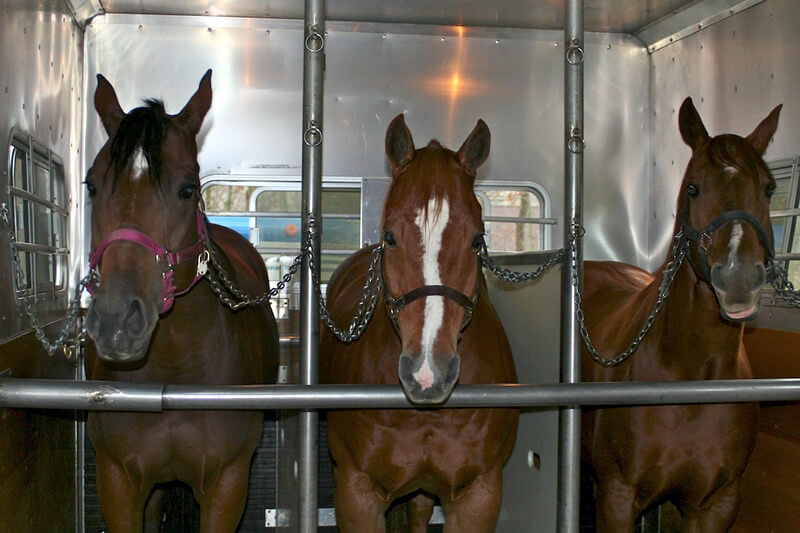
source: www.johnsonhorsetransportation.com
The basic principle is using tethers with secure fastening so it is possible to quicky free the horse in some stressful situation. If the pet is particularly nervous, it will be useful to tie them with the so-called "safety knot", which can be untied with one move, if the horse jiggles and scrabbles is quite helpful.
If we are dealing with a horse that left alone tries to untie himself - it's good to thing about some other, more solid knot that the safety one.
What's important is that the rope is long enough so the horse can balance his head in order to maintain the right position, but at the same time short enough so the pet cannot turn around, take his legs around the tether, sniff his companions or bow under the partition.
In the trailers we usually have a set chains covered with protective silicone or rubber tunnel, attached to the walls, so we don't have to make the tether on our won and we can fasten them after loading the horse inside.
More often than not double tethers are used in binding the horses, to make sure that the steed will not untie himself on the road.
Transport on colder days
When it comes to cool, or even cold days, it is good to put a rug on your pet. Usually fleece rugs are used in transport, and stable rugs during autumn and spring. Do not forget that too thick rugs may cause sweating at the horses which contribute to the loss of electrolytes and increases the horse's vulnerability to catch a chill after coming out of the warm vehicle. It's essential that the rug of our steed have a fastening under the abdomen, which prevent from its shifting on the back.
Control during the ride
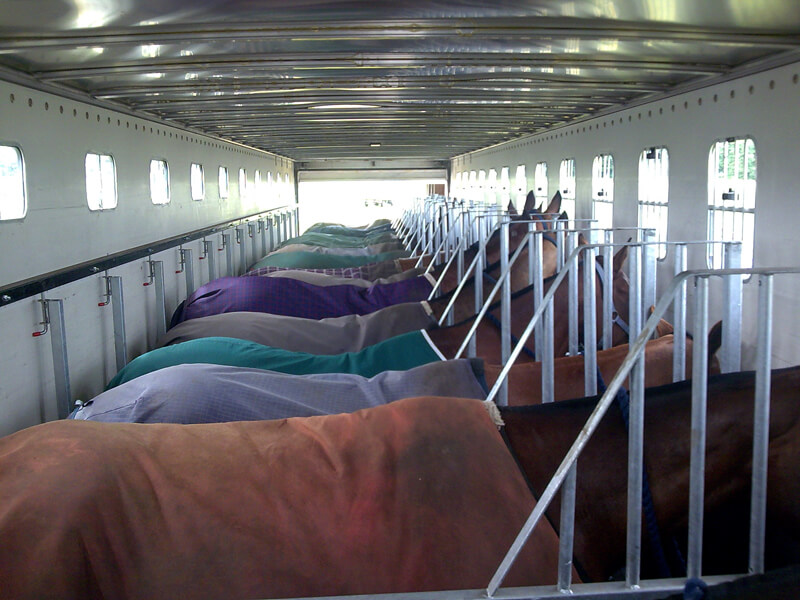
Horsetruck for 12 horses, source: horseandman.com
By law, the one-off transport of the horse cannot be longer that 24h, with breaks every 8h when you will water and feed them. Nonetheless, from the perspective of equine physiology transport which lasts longer than 8-10 hours is not recommended. Especially on hot days, we have to take breaks to water and cool the horses. Check if they don't have any injuries, if they're tied and if the protectors and rugs are alright. If the horses are carried for 10h, you should take a break in the middle of the journey, and walk them out giving them time to stretch, drink, defecate, and relax by cropping grass.
Currently, in modern trailers the montage of cameras becomes more and more popular, which allows the driver and his or her passengers to have a constant control over what is going on in the trailer and can quickly react to any undesired situations.
Additionally, observation of the horses during transport will allow us to draw conclusions for the future, concerning the order of positioning particular horses in order to increase their safety.
When we reach our destination
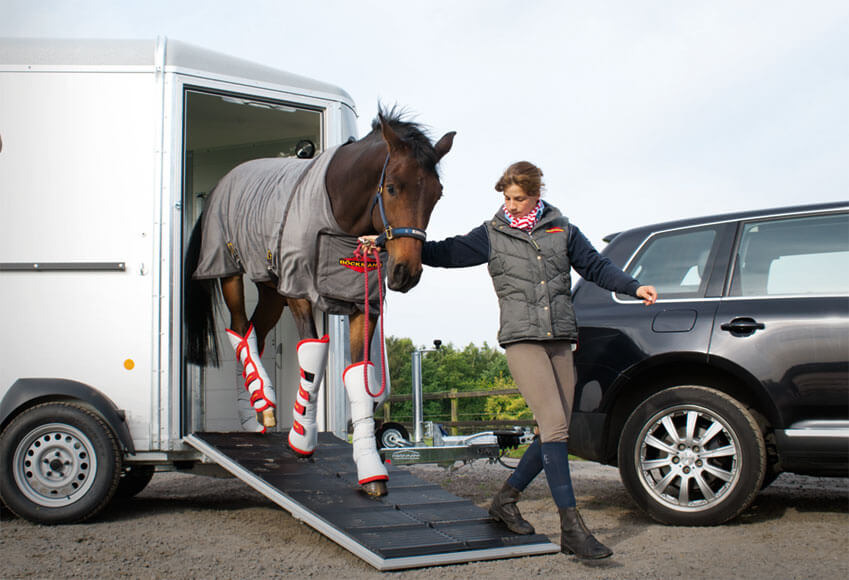
source: www.boeckmann-northamerica.com
After arriving and unloading the horse from the vehicle, you should provide him with water and the ability to stretch his legs on the grass and give him a moment of relaxation.
Note!
When the horse after transport is heated up or sweated, you should restrain the access to cold water, treating him like a sportsman after some serious effort, put on a sweat rug and walk him until he cools off. Only then you can give him water, but first check if it's not too cold.
During the horse's relaxation it is worth to take a close look at his body, whether he got come cuts during transport, especially his legs and hooves. Apart from the possibility of getting hurt, many horses might be stiff while moving after a long-lasting transport. Their muscles would be hard and painful - it is a signal that we are dealing with the after-transport myositis. You mustn't underestimate the issue. In this situation you should resign from participation in the competition. Such horse requires a very special treatment - walking in a slow walk, covering him with a rug and administering preparations with amino acids and antioxidants (for example vit. E, selenium) will prove helpful.
Note!
You should not perform an intense massage of the muscles or rub any calefacient specifics - it will only cause more damage to the muscles!
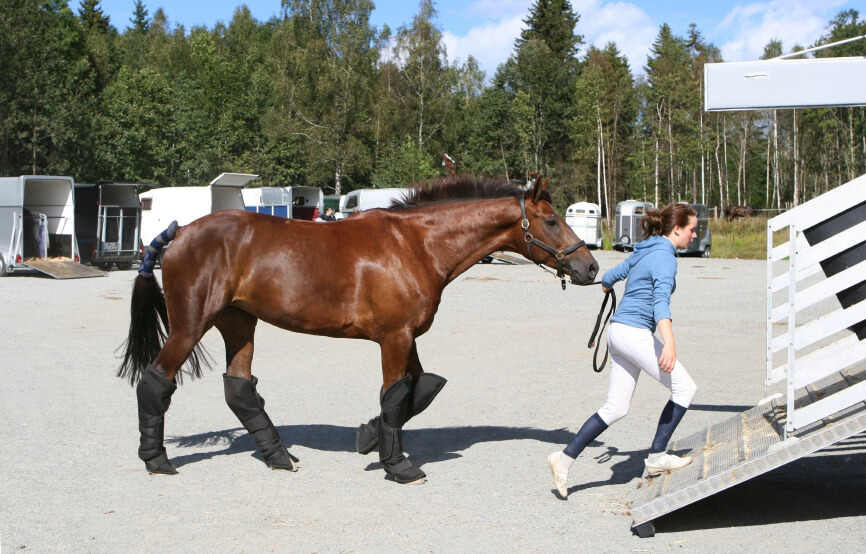
To sum up, it's up to us whether transportation will become a pleasant or a horrifying event. Dependently of how much time we are willing to spend on him and how well we will be prepared. Remember that all the preliminary actions should be made before we start loading the horse and it shouldn't be done on the competition day, when we lack patience and time. It would be a pity if the wrongly conducted transport not only ruined our start in the competition but also eliminated our horse from sport for longer.




 Trailer for two horses.
Trailer for two horses. Horsetruck for 10 horses.
Horsetruck for 10 horses. Interior of the Oakley Supremacy horsetruck for 6 horses, with lodgings for 6 people.
Interior of the Oakley Supremacy horsetruck for 6 horses, with lodgings for 6 people.
 source: horse-sport.home.pl
source: horse-sport.home.pl GO HORSE wrappers with backing.
GO HORSE wrappers with backing. ESKADRON tail protector.
ESKADRON tail protector. source: www.johnsonhorsetransportation.com
source: www.johnsonhorsetransportation.com Horsetruck for 12 horses, source: horseandman.com
Horsetruck for 12 horses, source: horseandman.com source: www.boeckmann-northamerica.com
source: www.boeckmann-northamerica.com

